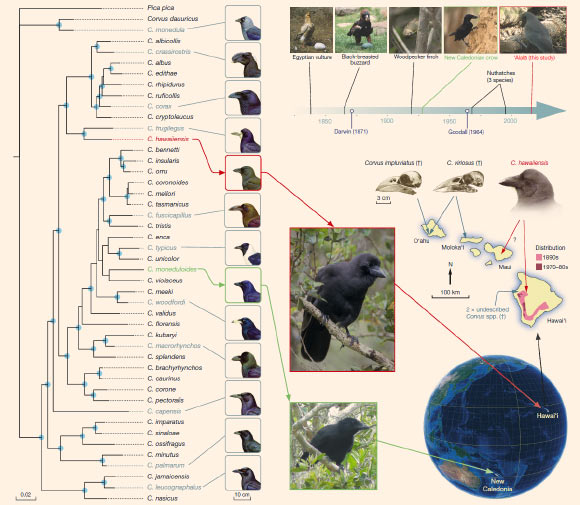A team of scientists led by Dr. Christian Rutz, a researcher at the Centre for Biological Diversity at the University of St Andrews, UK, has discovered that the Hawaiian crow (Corvus hawaiiensis), a tropical crow species, is a highly skilled tool user.

Captive Hawaiian crow (Corvus hawaiiensis) using a stick tool to extract food from a wooden log. Image credit: Ken Bohn / San Diego Zoo Global.
Tool use is extremely rare in the animal kingdom. According to recent estimates, the behavior has been documented in less than one percent of all known genera, and in an even smaller percentage of species. This rarity poses both an intriguing scientific puzzle, and major methodological challenges.
Ultimately, scientists hope to uncover how humans evolved their unsurpassed tool-using skills, but to achieve this, they need other tool-using species for comparison.
This is why the discovery of a second tool-using crow species is an important advance.
For decades, another species – the New Caledonian crow (Corvus moneduloides) – had baffled researchers with its remarkable tool using and making skills.
The big question was why these birds, but apparently no other members of the crow family (‘corvids’), had evolved such technological prowess. But without other tool-using crow species for comparison, the New Caledonian crow remained a puzzling oddity.
“We had previously noticed that New Caledonian crows have unusually straight bills, and wondered whether this may be an adaptation for holding tools, similar to humans’ opposable thumb,” Dr. Rutz said.

Phylogenetic and biogeographical context of tool behavior in crows. Image credit: Christian Rutz et al.
By searching for this tell-tale sign amongst some of the lesser-known corvid species, Dr. Rutz and co-authors quickly homed in on a particularly promising candidate for further investigation – the Hawaiian crow.
This species is best known by its indigenous Hawaiian name, ‘Alalā (pronounced: ‘a-la-lah). It is a bird of great cultural significance in Hawai‘i.
Following a population crash in the late 20th century, the Hawaiian crow is now sadly extinct in the wild.
As of September 2016, the world’s Hawaiian crow population comprises 131 birds, all of which are kept in two facilities, on Hawai‘i Island and Maui respectively.
“Although the ‘Alalā became extinct in the wild in the early 2000s, and currently survives only in captivity, at least two lines of evidence suggest that tool use is part of the species’ natural behavioral repertoire,” the researchers said.
“Juveniles develop functional tool use without training, or social input from adults; and proficient tool use is a species-wide capacity.”
The team tested 104 Hawaiian crows and found that 78 percent of birds spontaneously used tools to probe for out-of-reach food.
“Using tools comes naturally to ‘Alalā. These birds had no specific training prior to our study, yet most of them were incredibly skilled at handling stick tools, and even swiftly extracted bait from demanding tasks,” Dr. Rutz said.
“In many regards, the ‘Alalā is very similar to the New Caledonian crow, which my team has been studying for over 10 years.”
Interestingly, the researchers could demonstrate through extensive computer simulations that it is unlikely that a single bird once had a smart idea, which subsequently spread across the captive population through social learning.
The discovery of a second tool-using crow species finally provides leverage for addressing long-standing questions about the evolution of animal tool behavior.
“As crow species go, the ‘Alalā and the New Caledonian crow are only very distantly related,” Dr. Rutz said.
“With their last common ancestor living around 11 million years ago, it seems safe to assume that their tool-using skills arose independently.”
“It is striking that both species evolved on remote tropical islands in the Pacific Ocean that lack woodpeckers and ferocious bird predators – perfect conditions, apparently, for smart crows to become accomplished tool users.”
“I love learning about the discovery of tool use behaviors in other species of animals,” said Dr. Jane Goodall DBE, a world-renowned primatologist who provided the first detailed report of tool use in wild chimpanzees.
“This latest finding is especially wonderful. With two tool-using corvids, the well known Galapagos finches, and one vulture in the list of tool using birds, we can now make comparisons with avian and primate tool using.”
“Each of these discoveries shows how much there is still to learn about animal behavior, and it makes me re-think about the evolution of tool use in our own earliest ancestors,” said Dr. Goodall, founder of the Jane Goodall Institute and UN Messenger of Peace.
The team’s findings appear in the journal Nature.
_____
Christian Rutz et al. 2016. Discovery of species-wide tool use in the Hawaiian crow. Nature 537, 403-407; doi: 10.1038/nature19103
This article is based on a press-release issued by the University of St Andrews.







